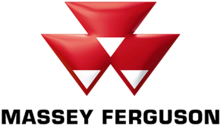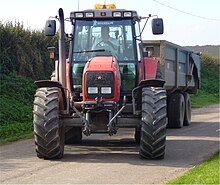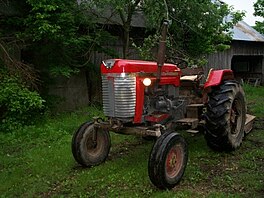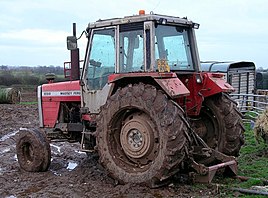Massey Ferguson
This article's lead section may be too short to adequately summarize the key points. (June 2021) |
 | |
| Type | Subsidiary |
|---|---|
| Industry | Manufacturing |
| Predecessors |
|
| Founded | 1953 (as Massey-Harris-Ferguson; shortened to Massey Ferguson in 1958) |
| Headquarters | Duluth, Georgia, United States |
| Products | Agricultural machinery, consumer and commercial equipment, financial services |
| Parent | AGCO |
| Website | masseyferguson |




Massey Ferguson Limited is an American manufacturer of agricultural machinery. The company was established in 1953 through the merger of farm equipment makers Massey-Harris of Canada and the Ferguson Company of the United Kingdom. It was based in Brantford, Ontario, until 1988. The company transferred its headquarters in 1997 to Buffalo, New York, before it was acquired by AGCO, the new owner of its former competitor Allis-Chalmers. Massey Ferguson is among several brands in a portfolio produced and marketed by American industrial agricultural equipment conglomerate AGCO and a major seller in international markets around the world.
History[]
Massey Manufacturing Co.[]
In 1847, Daniel Massey established the Newcastle Foundry and Machine Manufactory in what is now Newcastle, Clarington, Ontario, Canada.[2] The company made some of the world's first mechanical threshers, at first by assembling parts from the United States, but eventually designing and building its own equipment. Daniel Massey's son, Hart Massey, subsequently renamed the enterprise as the Massey Manufacturing Co. In 1879, the company moved to Toronto,[3] where it soon became one of the city's leading employers. The huge complex of factories, consisting of a 4.4-hectare (11-acre) site with plant and head office at 915 King Street West (now part of Liberty Village), became one of the best-known features of the city. The company expanded further and began to sell its products internationally.[3] Through extensive advertising campaigns, it became one of the most well-known brands in Canada. A labour shortage throughout the country also helped to make the firm's mechanized equipment very attractive.
Massey-Harris Limited[]


In 1891, the Massey Manufacturing Co. merged with A. Harris, Son and Company to form Massey-Harris Limited,[2][4] which became the largest agricultural equipment maker in the British Empire. Massey-Harris made threshing machines and reapers, as well as safety bicycles, introducing a shaft-driven model in 1898.[5] In 1910, Massey-Harris acquired the Johnston Harvester Company of Batavia, New York, making it one of Canada's first multinational firms.[2]
The company's early tractor models included the 20 horsepower Massey-Harris GP 15/22 (1930–36),[6] 25 horsepower 'Massey-Harris Pacemaker' (1936–1939),[7] 35 horsepower Model 101 (1938–1942),[8] , Model 20, Model 81, and .
Grain harvesting was revolutionized by Massey engineer in 1938, with the world's first self-propelled combine[2] — the No. 20. It was too heavy and expensive for extensive mass production, but served as a guide for the design of the lighter and less costly No. 21 which was tested in 1940, and put on sale in 1941. The Massey-Harris No. 21 Combine was commemorated with a Canada Post stamp on June 8, 1996.[9] E.P. Taylor, one of C.D. Howe's dollar-a-year men, joined the board of directors in 1942, and Eric Phillips joined management in 1946.
The final generation of Massey-Harris tractors, introduced immediately after World War II, included the 25-horsepower M-H 22 series,[10] the 35 horsepower M-H 33 series,[11] the 45 horsepower M-H 44 series[12] and the 55 horsepower M-H 55 series.[13] In 1952, the M-H 22 was replaced by the M-H 23 Mustang. In 1955, the 30-horsepower Massey-Harris 50 was introduced after the merger that created Massey-Harris-Ferguson. It was based on the Ferguson TO-35 and was also produced as the F-40 for Ferguson dealers. The MH-50 was available in several configurations: utility, high-crop utility, or row-crop with a choice of single, tricycle, or wide adjustable front ends. In 1956, the M-H 33 was replaced by the MH 333, while the M-H 44 was replaced by the M-H 444 and the M-H 55 was replaced by the M-H 555. These tractors were commonly known as the "triple series" and were mechanically similar to their predecessors, but featured new styling that included a slightly different hood design, chrome trim on the grill and hood, and a different color scheme. They were also available with power steering, live power take-off (PTO) and hydraulics. The Massey Harris triple series tractors remained in production until 1958.
Sawyer-Massey[]
In a complex turn of events, the Massey family turned to steam engine builder L.D. Sawyer & Company of Hamilton, Ontario, and started a line of steam tractors. These engines were quite successful and were built in a number of sizes. The 25 horsepower was popular, and the expanding Prairie provinces clamoured for big breaking engines. Massey also experimented with tandem compound engines. Sawyer Massey lasted only until 1910, when the firm was wound down, and Massey went into oil-fired internal combustion engines. Sawyer-Massey and Massey-Harris were two separate companies, both managed by the Massey family.
Wallis Gas Tractor and wider influence[]

Massey began experimenting with oil engines about 1910, with engines such as the Bulldog. However, success came only later in the 1920s with the Wallis line of tractors which was purchased by the firm.
In the 1930s, it introduced the first self-propelled combine harvester.[2] Massey Harris also produced one of the world's first four-wheel drive tractors. Hart Massey's sons , , and became closely involved in the business and eventually took over its operations. They were the last generation of Masseys to run Massey-Harris. Other members of the family went on to other accomplishments: Vincent Massey became Governor General of Canada and Raymond Massey became a noted actor in American films. The Massey family used its fortune to improve the city of Toronto and many institutions, such as the University of Guelph, University of Toronto, Upper Canada College, Crescent School, Appleby College, Massey Hall and Metropolitan United Church, were partially financed by the Masseys.
Rear lifting arm - Multiuse 3-point Hitch[]
So-called Ferguson system for multiuse 3-point hitch was developed by Harry Ferguson at 1926. The same system is still in use, and has developed from category 0 (less than 20 hp) to category 4 (more than 180 hp).
Military contracts[]
During and after World War II, Massey Harris undertook a number of contracts to produce tractors, tanks and self-propelled artillery vehicles for the United States Armed Forces.[2] Vehicles produced by Massey Harris include the following:
- M5 Stuart light tank (250 M5s, and 3,530 M5A1s built)[14]
- M24 Chaffee light tank
- M41 Howitzer Motor Carriage self-propelled artillery (built on M24 chassis[15])
- M44 self propelled howitzer (250 built in early 1950s on M41 Walker Bulldog tank chassis)
- M36 Jackson tank destroyer
- M19 Multiple Gun Motor Carriage Self-propelled anti-aircraft artillery vehicle (300 built)
- I-162 Military tractor built for the United States Army (25 built)
- I-244 Military tractor built for the United States Air Force, United States Navy, and United States Army Corps of Engineers in 1955 and 1956
- I-330 Military tractor built for the United States Navy (6 built)
Massey-Harris-Ferguson[]
In 1953, Massey-Harris merged with the Ferguson Company to become Massey-Harris-Ferguson, before finally taking on its current name in 1958.[2]
Massey Ferguson[]
The name was shortened to Massey Ferguson in 1958. They tried to consolidate the two dealer networks and product lines. Its television and radio advertising featured an upbeat jingle with a male chorus singing, "He's a get-up-early, keep-'em-rollin, Massey-Ferguson kind of a man." Nevertheless, the company soon began to decline financially after facing increasing international competition in the 1960s, when the firm began to struggle.
Hanomag-Cura, Argentina[]
In 1971, Massey purchased the local facilities of -Cura in Argentina, which had been established in 1960. The production of tractors and other agricultural implements, during until 1999. Some model numbers made in Argentina included 65R/250/252, 155, 150, 5160 S-2 / S-4, 5140 / 5140–4, 265, 255, 250, 250 S "viñatero", 8500 and 9500.
Other model numbers included 1075, 1078, 1095h, 1098, 1175 / 1175 S, 1185 / 1185 S, 1195 L / 1195 S-2/S-4, 1215 S-2 / S-4, 1340 S-2/S-4, 1360 S2/S4, 1615 L / S 1615 L, 1640, 1650, 1670, 1690, 1465, 1475 "Super alto, 1485, 1499 SX / 1499 L.
Sunshine, Australia[]
In 1955, Massey purchased the Australian manufacturers of Sunshine harvesters, H.V. McKay Pty Limited. Hugh Victor McKay had invented the combine harvester in 1884, the first machine to combine the functions of reaping, threshing and winnowing grain from a standing crop. By the 1920s, H.V. McKay Pty Ltd was running the largest implement factory in the southern hemisphere, covering 30.4 hectares (75 acres), and led the international agricultural industry through the development of the world's first self-propelled harvester in 1924.
In 1930, the H.V. McKay Pty Limited was granted exclusive Australian distribution of Massey-Harris machinery. The company was then renamed H.V. McKay Massey Harris Pty Ltd. Throughout World War II, H.V. McKay Massey Harris exported over 20,000 Sunshine drills, disc harrows and binders to England to facilitate the increase in food production.
In 1955, the remainder of H.V. McKay Pty Ltd was sold to Massey Ferguson. Manufacturing ended in 1986, and the last section was sold off and demolished in 1992. The former bulk store, factory gates and clock tower, the pedestrian footbridge, factory gardens, and head office complex still exist and are all listed on the Victorian Heritage Register.[16]
Landini[]
In 1959, Massey bought 100% of Landini, based in Italy. Landini has built many models for Massey over the years, especially vineyard and crawler models. Massey sold 66% to ARGO SpA in 1989, some to Iseki later on, and the final portion was sold to ARGO in 2000.
Perkins[]
In 1959, Perkins Engines from Peterborough, England was purchased. Perkins have been the main Diesel engine supplier for Massey Ferguson for many years.[2] In 1990, Massey Ferguson took over Dorman Diesels of Stafford and merged it with Perkins to form Perkins Engines (Stafford) Ltd. In the 1980s, Perkins purchased Rolls Royce (Diesels) Ltd, to form Perkins Engines (Shrewsbury) Ltd. In 1998, Perkins was sold off by then-owner LucasVarity to Caterpillar Inc., who were a major customer for their smaller and mid-sized engines; Caterpillar was a major producer of large Diesel engines for stationary and mobile application.[17]
Ebro of Spain[]
In 1966, Massey purchased 32% of the Spanish tractor and auto company Ebro, or Motor Iberica. Ebro had previously built Ford tractors under license, but now began building models for Massey, and Massey models under license. Massey sold its interest to Nissan in the 1980s.[18]
In the early 1960s, Massey Ferguson moved their head office from 915 King Street to the Sun Life Tower at 200 University Avenue in the Downtown Toronto.
In 1969, Massey Ferguson began producing a line of snowmobiles under the name 'Ski Whiz'. The snowmobile line was discontinued in 1977, due to a decline in sales.
Activities in Germany[]
In 1973, Massey purchased German Eicher tractor and many Massey-licensed Eichers were built. They later sold their interest and Dromson now owns Eicher which now builds specialized tractors for vineyards and such.
The firm then purchased control of Hanomag in 1974. After a loss of $250 million over the next five years, Hanomag was sold off.[19]
Conrad Black take-over[]
On 16 August 1978, Conrad Black, whose family had obtained control of Argus Corporation, an investor in Massey Ferguson, became active in Massey Ferguson's management.[20] The previous year, chairman received a $471,000 salary, the highest executive salary in Canada at the time.[21] During the 50 years between 1929 and 1979, the firm made more than 4% profit on its sales only five times. Under Black's leadership, Massey Ferguson instituted significant cost-cutting programmes that returned it to profitability. During the late 1970s, production was relocated to a new, large facility in Brantford, Ontario. In 1978, Massey Ferguson was the first to introduce an electronic control system for the three-point hitch on a tractor.[citation needed] However, a worldwide decline in the agricultural equipment market combined with high inflation, high domestic interest rates and a major recession, caused Massey Ferguson to slip into a loss once again. On 31 October 1979, Volkswagen AG made an informal offer for 51% of the firm, but was rebuffed by Black.[22] On 23 May 1980, Black resigned as chairman. In a subsequent series of detailed and lengthy letters to Herb Gray—the then Canadian Minister of Industry under the government of Pierre Trudeau—he remarked on the challenges faced by the firm, and outlined his solution, which would have seen the Canadian and Ontario governments as well as Argus Corporation refloat the ailing firm. Black failed to obtain a suitable response, and resolved to cut his losses.[23]
Renamed to Varity[]
In October 1980, Argus donated its shares in Massey Ferguson to the employee's pension plans, leading the way to a $250 million bail-out from the Government of Canada and the Province of Ontario for the collapsing business, which later was renamed Varity Corporation. In the mid-1980s, Varity spun off several money-losing divisions into an entity called Massey Combines Corporation in 1985. Massey Combines Corporation was headquartered in Brantford and became insolvent on 4 March 1988,[24] and its assets were re-acquired by Massey Ferguson.
Fermec sale[]
In 1992, a management buyout of MF Industrial created Fermec, which finally ceased trading in 2001 when it was taken over by the Terex Corporation, formerly a unit of General Motors. This encompassed all construction equipment from Massey. It was then purchased by Case Corporation in 1997.[25]
Varity left Toronto and relocated to their head offices to the Williams-Butler House at 672 Delaware Avenue in the Millionaire Row area of Buffalo, New York. The Toronto manufacturing complex has since been demolished, leaving only its head office building.
Despite its hardships, Massey Ferguson was selling 25% more tractors than its nearest competitors at this time. In 1995, Massey Ferguson's worldwide holdings were purchased by the United States-based AGCO Corporation. In August 1996, Varity merged with Lucas Automotive to become LucasVarity.
After a series of mergers and takeovers, the remains of LucasVarity were acquired by the United States company TRW. Since 1962, Massey Ferguson has been the world's leading tractor brand.[citation needed] Currently, there are more Massey Ferguson tractors than any other in the world.
Models[]

Massey Ferguson developed a wide range of agricultural vehicles and have a large share in the market across the world especially in Europe. In December 1957, the MF35 which was the first Massey Ferguson branded tractor rolled off the factory floor. It was a Ferguson design that started its life in 1955 as the Ferguson 35, often nicknamed "Gold Belly" due to the gold engine and gearbox. The 35s were massively popular and sold across the United Kingdom, Australia, Ireland and the United States. These were followed by other early models like the (MK1 indirect injection) 65 (MK2 direct injection).
The next big selling model was the MF135 which became widely popular because of its reliability and power compared to other tractors at the time.[citation needed] This was the first model in the MF 100 series. These included the MF 130, 133, 135, 145, 148, 150, 158, 165, 168, 175, 178, 180, 185 and 188.The same time the MF 100 series came out, the MF 1000 series was introduced. These include the MF 1080, 1100, 1130 and 1150. Later came the MF 550, 560, 565, 575, 590, 595 (500 series). From the mid-1970s and early 1980s came the 200 series tractor, which included the MF 230, 235, 240, 245, 250, 255, 260, 265, 270, 275, 278, 280, 285, 290, 298, 299.
In the mid-1980s, the short-lived 600 series was released. This included the 675, 690, 690T, 695, 698 and 699. The reason behind poor sales figures was due to unattractive styling and poor ergonomics, with the cab sitting much higher than previous MF tractors. Although the cab did give excellent visibility and a flat floor, being high off the ground meant it was best suited to field operations instead of livestock work. The 600 series was one of the first tractors to offer the user an option to control where the hydraulic fluid should be pumped. By moving a switch situated near the floor of the cab, the user could block off flow to the rear hydraulics and link arms, concentrating the full force of the pump on the front loader if equipped. In the late 1980s, one of the greatest selling tractors of all time was released- the 300 series Massey Ferguson. Excellent power, simplicity of cab, high range of gears and components made the MF 300 series a success especially in Europe. The range included the MF 340, 350, 352, 355, 362, 365, 372, 375, 382, 383, 390, 390T, 393, 394, 395, 398, 399 and 399T (the most powerful and popular Massey Ferguson 399) with horsepower ranging from 45HP to 104HP. The 300 series was also offered with a choice of cab, Hi-Line or Lo-Line. The Hi-Line cab featured a flat floor whilst the Lo-Line cab had a hump in the middle for the transmission tunnel. Some 'original' examples of the lower horsepower 300-series have been known to fetch prices exceeding £20,000 because of their rarity.
In the mid-1990s, the 6100 series and 8100 series were released including the 6150, 6180 and 8130.

Tractors that came after the 300 series included the 4200 range, the 4300 range, 3600 (early 1990s), 3000/3100 (early to mid-1990s), 3005/3105 (mid-1990s), 6100 (late 1990s), 6200 (late 1990s/early 2000s (decade)), 8200 (late 1990s/early 2000s), 5400, 6400, 7400, 8400 (2004-2007), 5600, 6600, 7600, 8600 (2009 to 2014), 5700, 6700, 7700, 8700, (2014-2018), 3700, 4700, 5700, 6700, (global series) 5700s, 6700s, 7700s, and 8700s
Today[]
Massey Ferguson currently produces 8600 series (limited markets), 5400 (limited markets), 5700s, 6700s, 7700s, and 8700s series tractors. New generation AGCO Power engines 8700 S Series provide levels of torque and horse-power unsurpassed in conventional tractor design, from the minimum of fuel. AGCO POWER 6 cylinder 8.4 L engines generate power from 270 to 405 hp.[26](AGCO Beauvais France) Massey Ferguson tractor production factories also build tractors marketed by AGCO under the "Challenger" brand and also specific model ranges for Iseki.
In June 2012, the Agco facility in Jackson, Minnesota, was expanded to start building Massey Ferguson and comparable AGCO "Challenger" models for the North American market.[27]
Since production commenced at AGCO Jackson, the facility has produced "7600" series and "8600" series Massey Ferguson tractors for the North American market. Currently, in production at the Jackson facility are the recently released 7700(s) and 8700(s) series Massey Ferguson tractors.

Product images[]

Massey Ferguson 35 (American type)

Massey Ferguson MF 3660
Massey Ferguson 698

Massey Ferguson self-propelled combine in use

Massey Ferguson Super 90 Diesel

Massey-Harris Clipper Combine c. 1950

The 1956 and 1957 Ferguson 40 wore this paint scheme. The Ferguson 40 was mechanically equivalent to the Massey Harris 50 and the Massey Ferguson 50. In the initial years after the Massy-Harris and Ferguson merger, Massey-Harris and Ferguson maintained separate model lines.

Massey Ferguson 8732
Licenses[]
Massey Ferguson is the most widely sold brand of agricultural machinery in the world. The brand and designs are or were licensed to a variety of companies around the world including:
- Ebro — Spanish company purchased and later sold by MF.
- Eicher — German company purchased and later sold by MF.
- Farmwell — assembled by Samarakoon Tractor Industries Private Limited in Sri Lanka.
- GIAD — assembled by the Giad Automotive Industry Co in Sudan.
- IMT — Industrija Mašina i Traktora in Yugoslavia.
- ITMCo — Iran Tractor Mfg Co in Iran. Own/sell under VenIran, TajIran, MFT and Eder Derdison names.
- Al Jedaa — Libyan tractor company, licensed to assemble tractors imported from the company (UK) and produce certain parts for use in assembly. Now shutdown.
- Landini — Italian company purchased and later sold by MF.
- Millat Tractors — license in Pakistan.
- Sutcliff — license built.
- Tractors and Farm Equipment Limited (TAFE) — assemble and license designs, in India.
- TajIran — joint venture between Iran Tractor and Homa Company in Tajikistan. Assembles tractors.
- Ursus SA — former licensee in Poland.
- Uzel — Uzel Tractor Plant in Turkey.
- VenIran — joint venture between Iran Tractor and Corporation Venezuela de Guayana in Venezuela. Assembles tractors.
- Zadrugar — of Yugoslavia. Built the MF 35 under license.
- Algerian Tractors Company — born in 2012 of a partnership between the ETRAG, the Algerian company of distribution of agricultural equipment (PMAT) and the US AGCO Massey Ferguson The factory is producing several Models Massey Ferguson tractors and one ETRAG tractor.[28]
See also[]
- Liberty Village — area where Massey Ferguson had a plant is now a residential neighbourhood with the company's head office at 915 King Street West still standing (by E. J. Lennox c. 1899) as Massey Harris Lofts.
Rival manufacturers:
- John Deere
- New Holland Agriculture
- Versatile
References[]
- ^ Pripps, Robert N. The Big Book of Farm Tractors (Vancouver, BC: Raincoast Books, 2001), p. 104.
- ^ Jump up to: a b c d e f g h Newman 1982, p. 146
- ^ Jump up to: a b Martin, Joseph E. (2017). "Titans". Canada's History. 97 (5): 47–53. ISSN 1920-9894.
- ^ Unofficial Massey-Harris home page Archived 2012-03-05 at the Wayback Machine
- ^ Canada Science and Technology Museum – A New Model Every Year Archived 2010-05-09 at the Wayback Machine. Retrieved 2010-05-03.
- ^ Easterlund, Peter. "TractorData.com Massey-Harris GP 15/22 tractor information". www.tractordata.com.
- ^ Easterlund, Peter. "TractorData.com Massey-Harris Pacemaker tractor information". www.tractordata.com.
- ^ Easterlund, Peter. "TractorData.com Massey-Harris 101 Super tractor information". www.tractordata.com.
- ^ Massey-Harris No. 21 Combine commemorative stamp bulletin
- ^ Easterlund, Peter. "TractorData.com Massey-Harris 23 Mustang tractor information". www.tractordata.com.
- ^ Easterlund, Peter. "TractorData.com Massey-Harris 333 tractor information". www.tractordata.com.
- ^ Easterlund, Peter. "TractorData.com Massey-Harris 44 Special tractor information". www.tractordata.com.
- ^ Easterlund, Peter. "TractorData.com Massey-Harris 55 tractor information". www.tractordata.com.
- ^ "M5 Stuart". Tanks Encyclopedia. Retrieved 30 March 2016.
- ^ "M41 155mm Howitzer Motor Carriage". Military History Encyclopedia of the Web. Retrieved 30 March 2016.
- ^ Victorian Heritage Database Report: Massey Ferguson Complex
- ^ The Massey Legacy, by John Farnworth, ISBN 978-0-85236-403-1
- ^ FOMCC. "Ford Iberica - Ebro". fomcc.de.
- ^ Newman 1982, pp. 150–1
- ^ Newman 1982, p. 154
- ^ Newman 1982, p. 150
- ^ Newman 1982, p. 158
- ^ Newman 1982, pp. 160–163
- ^ Per MCC Employee
- ^ "Construction - Terex Corporation". fermec.com. Archived from the original on 2006-11-18. Retrieved 2019-10-03.
- ^ "Massey Ferguson 8735 Specifications". specstch.com.
- ^ "Video Interview: Jackson Manufacturing Expansion - AGCO Blog". blog.agcocorp.com.
- ^ "Archived copy". Archived from the original on 2017-02-02. Retrieved 2016-09-01.CS1 maint: archived copy as title (link)
Sources[]
- Pripps, Robert N. The Big Book of Farm Tractors. Vancouver, BC: Raincoast Books, 2001. ISBN 978-1-55192-393-2.
- Newman, Peter C. The Establishment Man: A Portrait of Power. McClelland and Stewart, 1982. ISBN 0-7710-6786-0.
External links[]
| Wikimedia Commons has media related to Massey Ferguson. |
- Massey Ferguson
- Defunct manufacturing companies of Canada
- Lawn and garden tractors
- Tractor manufacturers of Canada
- Tractor manufacturers of France
- Tractor manufacturers of the United Kingdom
- Manufacturing companies established in 1847
- Manufacturing companies disestablished in 1996
- 1847 establishments in Ontario
- 1996 disestablishments in New York (state)
- AGCO
- Canadian companies established in 1847







